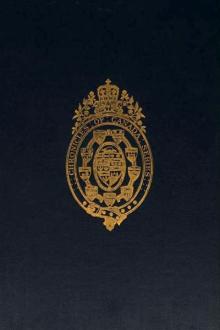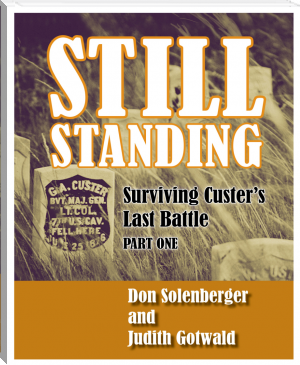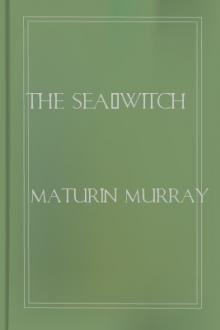The Mariner of St Malo by Stephen Leacock (early readers .TXT) 📕

- Author: Stephen Leacock
- Performer: -
Book online «The Mariner of St Malo by Stephen Leacock (early readers .TXT) 📕». Author Stephen Leacock
From time to time the explorers had caught sight of painted savages, with heads adorned with bright feathers and with bodies clad in the skins of wild beasts. They were roving upon the shore or passing in light boats made of bark among the island channels of the coast. ‘They are men,’ wrote Cartier, ‘of an indifferent good stature and bigness, but wild and unruly. They wear their hair tied on the top like a wreath of hay and put a wooden pin within it, or any other such thing instead of a nail, and with them they bind certain birds’ feathers. They are clothed with beasts’ skins as well the men as women, but that the women go somewhat straighter and closer in their garments than the men do, with their waists girded.
They paint themselves with certain roan colours. Their boats are made with the bark of birch trees, with the which they fish and take great store of seals, and, as far as we could understand since our coming thither, that is not their habitation, but they come from the mainland out of hotter countries to catch the said seals and other necessaries for their living.’
There has been much discussion as to these savages. It has been thought by some that they were a southern branch of the Eskimos, by others that they were Algonquin Indians who had wandered eastward from the St Lawrence region.
But the evidence goes to show that they belonged to the lost tribe of the ‘Red Indians’ of Newfoundland, the race which met its melancholy fate by deliberate and ruthless destruction at the hands of the whites. Cabot had already seen these people on his voyage to the coast, and described them as painted with ‘red ochre.’ Three of them he had captured and taken to England as an exhibit. For two hundred years after the English settlement of Newfoundland, these ‘Red Indians’ were hunted down till they were destroyed. ‘It was considered meritorious,’ says a historian of the island, ‘to shoot a Red Indian. To “go to look for Indians” came to be as much a phrase as to “look for partridges.” They were harassed from post to post, from island to island: their hunting and fishing stations were unscrupulously seized by the invading English. They were shot down without the least provocation, or captured to be exposed as curiosities to the rabble at fairs in the western towns of Christian England at twopence apiece.’ So much for the ill-fated savages among whom Cartier planted his first cross.
On June 15, Cartier, disappointed, as we have seen, with the rugged country that he found on the northern shore, turned south again to pick up the mainland, as he called it, of Newfoundland. Sailing south from Brest to a distance of about sixty miles, he found himself on the same day off Point Rich on the west coast of Newfoundland, to which, from its appearance, he gave the name of the Double Cape. For three days the course lay to the south-west along the shore. The panorama that was unfolded to the eye of the explorer was cheerless. The wind blew cold and hard from the north-east. The weather was dark and gloomy, while through the rifts of the mist and fog that lay heavy on the face of the waters there appeared only a forbidding and scarcely habitable coast. Low lands with islands fringed the shore. Behind them great mountains, hacked and furrowed in their outline, offered an uninviting prospect. There was here no Eldorado such as, farther south, met the covetous gaze of a Cortez or a Pizarro, no land of promise luxuriant with the vegetation of the tropics such as had greeted the eyes of Columbus at his first vision of the Indies. A stormbound coast, a relentless climate and a reluctant soil-these were the treasures of the New World as first known to the discoverer of Canada.
For a week Cartier and his men lay off the coast. The headland of Cape Anguille marks the approximate southward limit of their exploration. Great gales drove the water in a swirl of milk-white foam among the rocks that line the foot of this promontory. Beyond this point they saw nothing of the Newfoundland shore, except that, as the little vessels vainly tried to beat their way to the south against the fierce storms, the explorers caught sight of a second great promontory that appeared before them through the mist. This headland Cartier called Cape St John. In spite of the difficulty of tracing the storm-set path of the navigators, it is commonly thought that the point may be identified as Cape Anguille, which lies about twenty-five miles north of Cape Ray, the south-west ‘corner’ of Newfoundland.
Had Cartier been able to go forward in the direction that he had been following, he would have passed out between Newfoundland and Cape Breton island into the open Atlantic, and would have realized that his New Land was, after all, an island and not the mainland of the continent. But this discovery was reserved for his later voyage. He seems, indeed, when he presently came to the islands that lie in the mouth of the Gulf of St Lawrence, to have suspected that a passage here lay to the open sea. Doubtless the set of the wind and current revealed it to the trained instinct of the pilot. ‘If it were so,’ he wrote, ‘it would be a great shortening as well of the time as of the way, if any perfection could be found in it.’ But it was just as well that he did not seek further the opening into the Atlantic. By turning westward from the ‘heel’
of Newfoundland he was led to discover the milder waters and the more fortunate lands which awaited him on the further side of the Gulf.
THE FIRST VOYAGE—THE GULF OF ST LAWRENCE
On June 25 Cartier turned his course away from Newfoundland and sailed westward into what appeared to be open sea.
But it was not long before he came in sight of land again.
About sixty miles from the Newfoundland shore and thirty miles east from the Magdalen Islands, two abrupt rocks rise side by side from the sea; through one of them the beating surf has bored a passage, so that to Cartier’s eye, as his ships hove in sight of them, the rocks appeared as three. At the present time a lighthouse of the Canadian government casts its rays from the top of one of these rocky islets, across the tossing waters of the Gulf.
Innumerable sea-fowl encircled the isolated spot and built their nests so densely upon the rocks as to cover the whole of the upper surface. At the base of one of these Bird Rocks Cartier stopped his ships in their westward course, and his men killed great numbers of the birds so easily that he declared he could have filled thirty boats with them in an hour.
The explorers continued on their way, and a sail of a few hours brought them to an island like to none that they had yet seen. After the rock-bound coast of the north it seemed, indeed, a veritable paradise. Thick groves of splendid trees alternated with beautiful glades and meadow-land, while the fertile soil of the island, through its entire length of about six miles, was carpeted with bright flowers, blossoming peas, and the soft colours of the wild rose. ‘One acre of this land,’ said Cartier, ‘is worth more than all the New Land.’ The ships lay off the shore of the island all night and replenished the stores of wood and water. The land abounded with game; the men of St Malo saw bears and foxes, and, to their surprise they saw also great beasts that basked upon the shore, with ‘two great teeth in their mouths like elephants.’ One of these walruses,—for such they doubtless were,—was chased by the sailors, but cast itself into the sea and disappeared. We can imagine how, through the long twilight of the June evening, the lovely scene was loud with the voices of the exultant explorers. It was fitting that Cartier should name this island of good omen after his patron, the Seigneur de Brion, admiral of France. To this day the name Brion Island,—corrupted sometimes to Byron Island,—recalls the landing of Jacques Cartier.
From this temporary halting-place the ships sailed on down the west coast of the Magdalen Islands. The night of June 28 found them at anchor off Entry Island at the southern end of the group. From here a course laid to the south-west brought the explorers into sight of Prince Edward Island. This they supposed to be, of course, the mainland of the great American continent. Turning towards the north-west, the ships followed the outline of the coast. They sailed within easy sight of the shore, and from their decks the explorer and his companions were able to admire the luxuriant beauty of the scene. Here again was a land of delight: ‘It is the fairest land,’
wrote Cartier, ‘that may possibly be seen, full of goodly meadows and trees.’ All that it lacked was a suitable harbour, which the explorers sought in vain. At one point a shallow river ran rippling to the sea, and here they saw savages crossing the stream in their canoes, but they found no place where the ships could be brought to anchor.
July 1 found the vessels lying off the northern end of Prince Edward Island. Here they lowered the boats, and searched the shore-line for a suitable anchorage. As they rowed along a savage was seen running upon the beach and making signs. The boats were turned towards him, but, seized with a sudden panic, he ran away. Cartier landed a boat and set up a little staff in the sand with a woollen girdle and a knife, as a present for the fugitive and a mark of good-will.
It has been asserted that this landing on a point called Cap-des-Sauvages by Cartier, in memory of the incident, took place on the New Brunswick shore. But the weight of evidence is in favour of considering that North Cape in Prince Edward Island deserves the honour. As the event occurred on July 1, some writers have tried to find a fortunate coincidence in the landing of the discoverer of Canada on its soil on the day that became, three hundred and thirty-three years later, Dominion Day. But the coincidence is not striking. Cartier had already touched Canadian soil at Brest, which is at the extreme end of the Quebec coast, and on the Magdalen Islands.
Cartier’s boats explored the northern end of prince Edward Island for many miles. All that he saw delighted him.
‘We went that day on shore,’ he wrote in his narrative, ‘in four places, to see the goodly sweet and smelling trees that were there. We found them to be cedars, yews, pines, white elms, ash, willows, With many other sorts of trees to us unknown, but without any fruit. The grounds where no wood is are very fair, and all full of peason [peas], white and red gooseberries, strawberries, blackberries, and wild corn, even like unto rye, which seemed to have been sowed and ploughed. This country is of better temperature than any other land that can be seen, and very hot. There are many thrushes, stock-doves, and other birds. To be short, there wanteth nothing but good harbours.’
On July 2, the ships, sailing on westward from the head of Prince Edward Island, came in sight of the New Brunswick coast. They had thus crossed Northumberland Strait, which separates the island from the mainland. Cartier, however, supposed this to be merely a deep bay, extending inland on his left, and





Comments (0)